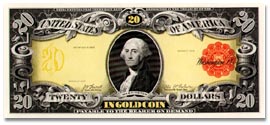NEW YORK (CNN/Money) -
If America reacts negatively to the new twenty-dollar bill, it won't be the first time money has caused controversy.
Remember the Susan B. Anthony dollar? It was the first U.S. currency to feature an historical female figure since the 19th century, when Martha Washington adorned a silver-backed note.
Citing the cost-saving and efficiency benefits of coins over bills, the Treasury Department promoted it as "the dollar of the future." Amid great fanfare, the U.S. Mint produced nearly one billion of them between 1979 and 1981 (as well as a smaller re-minting in 1999).

The piece itself was supposed to have looked and felt different from other change. Instead, it seemed like a quarter with that funny hendecagon (an 11-sided polygon) on its face. As for the great suffragist it honored, well, more than a few wags joked about her striking resemblance to George Washington.
Vast national indifference soon rendered the Anthony dollar as another quaint relic of the Seventies, like the Ford administration's WIN ("Whip Inflation Now") buttons or the AMC Pacer.
Unlike the Anthony dollar, Americans will be forced to use the new bills. So public reaction, whether vibrant or muted, really won't matter.
For example, many griped when the last rollout of new bills -- the fat-head series, you might call it -- came in the 1990s. "We all pooh-poohed it, but we use it," said Stephen L. Bobbitt, a spokesman for the American Numismatic Association in Colorado Springs. "What other choice do we have?"
For more on the new twenty, click here.
Money woes: a history
Over the years, America's moneymakers have had their share of disappointments and failures. Here are just a few of them:

Sacagawea dollar: In 1999, Treasury announced it would take another stab at a dollar coin. This time, it honored the Shoshone woman with the difficult name, who helped guide Lewis and Clark across the West. To distinguish it from other coins, the piece has a brass-colored coating � which rubs off with even minimal handling.
Three years after its introduction, a General Accounting Office poll found that 97 percent of the nation had not used the coin within the past month, and that 74 percent could not remember ever using one.
The 2-dollar bill: The note honors Thomas Jefferson on its front, and the signers of his Declaration of Independence on the back.

The bill is so obscure that the Treasury Department's Web site contains an explanation to remind us that it is official U.S. currency, which had another series printed during the Clinton administration. "It's very popular at dog tracks and horse races," says Bobbitt. "The only thing it's good for is making a two-dollar bet."
Bare-breasted woman (part 1): In the 1890s, an "education series" of notes sought to teach Americans about science and history. An imprint about electricity, however, reminded many about the birds and the bees: the exposed left breast of a stylized goddess appeared on the bill. Outcry forced the notes to be recalled and reprinted with a model wearing clothing.
| Related stories
|

|
|
|
|
Bare-breasted woman (part 2): Long before the dollar-coin fiasco, Treasury officials apparently believed that no mistake is ever so great that it can't be made twice. The Liberty quarter, issued during World War I, also proved too risque in its first edition. This time, however, it was the right breast that saw the light of day. Again, the national decency brigade forced an expensive recall.
Another technicolor production
Of course, many Treasury Department innovations have been successes. The use of green on the currency, for example, was a happy historical occurrence, born during the Civil War years. At the time, the new science of photography had some treacherous implications. Since color photographic inks had not been invented, green was added to notes to foil counterfeiters trying to use photography to reproduce notes.

The new twenty-dollar note is also not the first time Treasury has issued multi-colored bills. In the early part of the twentieth century, the twenty bore George Washington's picture. Today, it's known by collectors as the "technicolor note," for its striking assortment of hues. The front contains yellow, red, green and black inks, and the back features a bright gold design.
The technicolor was always popular, and it still is. You can buy one on eBay -- for about thirty times the face value.

|

